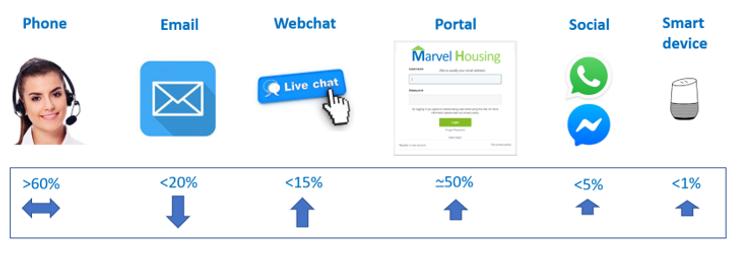
We have seen in the consumer world how almost every age demographic has taken to conversational messaging /chat Apps because they are quick and easy to use from your device of choice. Many show your availability, read/unread messages and a person’s location. This helps set expectations as to whether they can expect an immediate response or will have to wait for a reply.
For consumers, chat is typically accessed via an App on the phone, such as SMS, WhatsApp, Facebook Messenger or through a chat facility on a website or within applications. Gen Z and Millennials are the most prolific users with their time spent mostly on Instagram, Snapchat and TikTok. They are quick and simple to use and offer real-time updates and responses.
Historically housing associations had far better communications tools than their customers, but this was turned on its head when Smartphones and Apps became mainstream. Many housing associations are only now rolling out Unified Communications systems that offer calls, messages, availability/location services and video calls that replicate the apps that consumers love. Unfortunately, the chat/messaging, presence and video features are typically only available to internal employees, not for customer communications. Adding the latest Contact Centre technology addresses some of these gaps by centrally managing voice calls, email, Webchat and possibly social channels. But for customers, in most cases they see no service improvement. They still queue to speak with someone by phone, send an email, fill in a web form, or receive a text message! Only with webchat (or a few with Social channels) do customers get a chat style interface. And in most cases they still wait in a queue to chat with someone.
Existing Communications
The channels customers use to communicate and retrieve information. Statistics are the average from across 50 HA’s polled in 2021/2022. The Rise of Messaging Apps For business use, conversational messaging can provide new ways for customer engagement that offers a better and more personalised experience than most of the traditional channels. But a simple two way style of chat will only get good uptake if it has 24/7 service availability, self-serve capabilities, quick or instant responses, automation and integration to business systems, and a choice of touchpoints.

The majority of housing associations now offer a customer portal, which does empower customers to do more themselves but often with limitations. Depending on the portal provider and the housing applications in place, customers may or may not get access to a good range of services (Repairs, rent, property info, ASB). Typically the portals do not have integral knowledgebases, they are not conversational and they can be fiddly to access from smartphones. Whilst adoption rates are increasing, many customers choose not to sign up to them or use them regularly.
The Modern Consumer

The always-connected modern consumer is becoming much more demanding and used to instant responses and updates in their personal communications. So much so that their expectations on businesses and brands is that any desired service be available at their moment of need, whatever time of day. They have become impatient and if the info they need takes longer than a minute to find or it is difficult to transact or get a response to an enquiry, they often give up. Many consumers will try to self-serve first, using Search, Knowledgebases’, How to Videos and Portals or Apps. But if it isn’t quick and convenient they will try webchat (if available), phone in or vent their anger in a social post. Customer experience has become a key differentiator for keeping customers happy and monitoring service excellence.
Both Apple and Google have developed next-gen messenger offerings for business to consumer use on smartphones that will supersede SMS. Apple Business-Chat and Android RCS (Rich Communication Services) both offer a rich conversational interface that supports text, images, videos, audio messages and more. Although several businesses have introduced them their adoption has been slow to take off for various technical reasons.
Speech Driven Services (Messaging Apps with Speech)
Whilst the majority of users have been typing and tapping their messages, there are a growing number adopting speech interfaces which are much more convenient. More and more applications are beginning to add a microphone button next to the typing area so that your speech is transcribed as you speak and then sent as text. The new tools are simple and intuitive, and offer the choice of text or speech. Some apps are adding voice notes, where you record your message, edit if required and send. It takes seconds to compose, is super easy for the recipient to listen to the message and respond (like a modern update on voicemail) and is more personalised.
Messaging Apps for Business use
But do businesses want to offer these chat style of interfaces for customer service? Is this the best approach to communicate, transact and provide instant help and support across a diverse range of topics? Will customers adopt multiple media formats including messaging, speech, images, videos? That’s a definite yes. We hear a growing number of requests from businesses that want to use applications like WhatsApp for customer communications. But is it WhatsApp specifically they want or is it an easily accessible, simple to use, conversational interface? Although some businesses are using WhatsApp for customer interactions there are many who are reticent to share confidential information across the platform. Holding general conversations may be fine but sending passwords or personal data that identifies and verifies the user and the exchanging of confidential information / transactions may be best kept away from social messenger platforms. Whether its WhatsApp or any of the apps discussed, it is clear that businesses can benefit from conversational interfaces that offer instant responses to enquiries whether customers are communicating with live advisors or virtual agents.
Introducing Automation to Customer Service
To serve customers with better, faster and more effortless digital experiences than ever before will require automation to be introduced. All the most recent statistics confirm that customers want to self-serve and mobile messaging is where consumers are spending the majority of their time. Chat and speech interfaces offer instant, informed and personalised responses that solve their problems and save them time. We have seen Chatbots and Intelligent Virtual Assistants (IVAs) start to offer chat interfaces but with very different levels of success. Some add significant value to a business and can replicate a live advisor, but the majority offer basic FAQs with limited intelligence, no business data connectivity, no hand-off to existing contact centres; therefore effectively operating in a silo. Only when you choose the right platform encompassing Conversational AI, advanced speech technology, a Low-Code integration framework and contact centre connectors can you begin offering some transformational services to your customers.
Speech Driven Automation
Smart devices with Speech Assistants have become more common with Alexa leading the way and Google Assistant not far behind. Mobile phones have inbuilt Virtual Assistants such as Siri and Bixby, and Alexa or Google Assistant are also available to download. Adoptions rates are rising due to the convenience and ease of use and speech technology is constantly improving its accuracy and understanding of requests. Speech is also a more natural interface for the elderly and for many disabled users as it removes the challenge of typing on a small screen or with a small keyboard. Many new developments in speech technology are focussed on users who struggle to be understood, this will open up new possibilities for future communications. Currently the majority of apps and platforms do not offer speech driven services, but in the future you will see this changing.
Speech Assistants for Business Use
The common Speech Assistants capture their information from the Internet, they aren't connected to business data. They cannot answer detailed requests about your organisation. Alexa and Google Assistant are the same, unless you set up advanced Alexa skills or equivalent it will not help customers with their specific personal queries. The information your audience requires may be publicly available on the Internet within your website. But when they contact your business, it is to find information that they can't readily access, which is likely to be within a database or business application. If Speech Assistants are to offer the same level of service as your Customer Service Advisors they will need to access multiple housing applications, to identify / validate the caller and then respond to specific enquiries. Intelligent Speech Assistants offer this and more, and are accessible through a phone call or from a chat interface on your customer smartphone. Examples of what a chatbot or IVA can do include:
- Act as a virtual Operator / Receptionist and transfer calls where required
- Answer simple and complex questions
- Identify and security check a customer (using a housing application or CRM system)
- Triage repairs – Confirm, book, amend or cancel an appointment
- Check a rent balance and last payment date, or take a payment
- Confirm a gas service date
How Will Businesses Use Messaging Apps In The Future?
Businesses are now looking to serve customers through Chat and Messaging interfaces. To offer the best experience a chat interface must be simple and convenient and offer fast and personalised responses. Something that looks and behaves like WhatsApp, and can be driven by messaging or speech. It will automate responses (to offer instant support) and blend self-service, assisted service and live service, as and when required. It will be connected to the businesses data to respond with information that is contextual and present it in the most suitable way. A simple admin GUI will enable the Customer Service team to administer the customer journeys and workflows without requiring IT or outsourced support. The easier it is to build these journeys the broader the service can become to support multiple departments.
Choosing The Right Messaging Platform for Business
Offering the features we have already mentioned isn't easy, the global messaging platforms aren't customisable for individual businesses across a plethora of sectors. Automating speech driven services that support multiple dialects, accents and languages with high accuracy across a ranges of diverse and complex topics is extremely difficult to get right. Allowing these interfaces to securely retrieve data from multiple housing applications, accessing relevant information and then presenting it in a conversational way either visually or over speech is also not for the faint-hearted and requires powerful middleware within the platform.
Adaptive and Contextual Chat Interfaces
As well as the features discussed, future customer communications need to be conversational and multi-modal. Some conversations are better resolved with speech, others with text or in many cases it will be far easier to interact or transact using images, videos or custom content. With dynamic access to customer data the context of the conversation can become predictive and suggest the most likely reason for contact. Conversations will be adaptive; customers may start with messaging, move to speech and then view a video. Interactions will be monitored and analysed and service improvements will be automated.
No-Code and Low-Code
Designing customer journeys, adding the responses and updating company information over-time is not the responsibility of IT so the management of your Intelligent Virtual Assistants should not be a technical exercise. The Customer Service Team are at the coalface daily and understand why their customers are contacting them. They have the knowledge and expertise to answer customer queries and therefore are the perfect fit for administering the automation platform. This requires the platform to have an intuitive interface that almost anyone can use with a small amount of training. A No-Code interface is the perfect tool where it is simple to create and amend responses. The workflow builder should easily enable text, buttons, images, videos, maps etc to be inserted into the flow and offer drag and drop components for workflows such as transfer, send email/SMS, capturing data or accessing the APIs that the IT team make available.
Where Low-Code interfaces significantly add value is enabling the connectivity to all of your business applications to access relevant, real-time data. Low-Code middleware enables people with little or no coding experience to use a visual programming tool to create the API’s that the customer service team can drop into their flows. Both No-Code and Low-Code tools significantly reduce the cost of running the platform as in-house resources can manage everything.
Can Your Business Improve Its Customer Service With Messaging Apps?
Many digital transformation projects have been completed to make it easier or more cost effective for the business rather than improving the service for the customer. Conversational messaging and chat style apps make the service better for the customer and the business. The technology is now available to deliver services in new ways so that customers get a better, faster and easier experience using a digital channel of their choice.

If customers phone in, they will receive a better service than being on hold in a queue to speak with someone. Starting a chat/messenger session will be instant, informative and personalised. Customer portals will offer valuable services but they will incorporate an Intelligent Virtual Assistant that can assist and tap into the relevant knowledgebase. And for some customers there is even the option to speak with a digital human (life-like avatar) that assists them with their enquiry whilst showing empathy and being courteous.
Customer service automation incorporating Conversational AI, Intelligent Speech Assistants and Virtual Agents have come a long way in recent years and there is much more to consider when choosing a platform. If you would like to see how many of our customers in the housing sector are using this technology, or arrange a live demonstration then please get in touch.
Next Steps
So if you are looking to make yourself stand out amongst social housing providers, contact us or call us on 0333 6000 360. You can also download this blog as a PDF.
More blogs
converse360 Launches Live Chat
November 27, 2025







